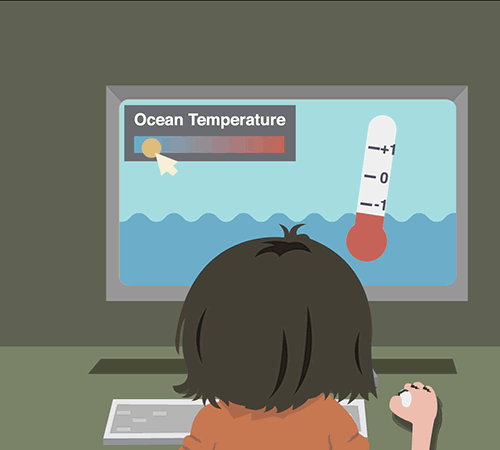Scientists use computer programs called climate models to understand how our planet is changing.
What Exactly Is Climate?

Caption: Mountains in Alaska’s Brooks Range seen as part of NASA’s Operation IceBridge. Credit: NASA/Michael Studinger
Weather is a specific event—like a rain storm or hot day—that happens over a short period of time. A weather forecast can tell you what the weather will be like in a few hours or days from now.
Climate, on the other hand, is the average weather conditions in a place over a long period of time—30 years or more. How do scientists predict what Earth’s climate will be like in the future? They use special computer programs called climate models.
What Is a Climate Model?
Climate models are simulations. A simulation is a way for us to understand something that would be difficult to experience in real life. For example, the average person isn’t allowed to drive a race car. However, simulations—like video games—can help you experience what it would be like to zoom around a racetrack.
A climate model is a simulation of all the factors that can affect Earth’s climate. Some of these factors are things that don’t really change, such as a region’s distance from the shore, elevation and latitude. Some of the factors are things that do change, such as the seasons, big volcanic eruptions, air pollution or—over millions of years—the shifts in the continents.
In the real world, all of these things are connected, and in the model they are too.
This video uses climate model data to show a prediction of how global temperatures will change throughout this century. Credit: NASA Scientific Visualization Studio.
How Is a Climate Model Used?
Climate models work like a laboratory in a computer. They allow scientists to study how different factors interact to influence a region’s climate.
Say that a scientist wants to know what would happen if the temperature of the oceans suddenly changed. We don’t have a spare Earth that we can use for experiments, so the model lets us test ideas that would be impossible or dangerous to actually do.
In a climate model, a scientist can change the temperature of the oceans safely inside a computer. The model then figures how lots of other things would change because of the warming oceans.
At the end of the calculation, the model might show, for example, that a slightly warmer ocean could cause big changes in Earth’s climate. It could also show how this small change could have long-term effects. The model could help scientists understand how a change in ocean temperature affects Earth’s climate 10 years from now, 100 years from now, or 1,000 years from now.
How Do We Know That Climate Models Are Accurate?
NASA’s Earth-observing satellites collect a lot of information about our planet and its atmosphere. Scientists gather information about past climates from very old trees and ice drilled from deep within glaciers. Using all of this information, scientists can understand how changes in our planet or atmosphere have affected climate over time.
For example, say that we know that ocean temperatures have warmed at some point in the past—and we also know what affect that change had on Earth’s climate. We can use that information to check if a model’s predictions of similar changes in the future are accurate.














